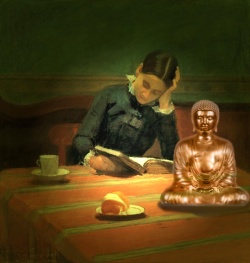Why Beauty Matters in Vajrayana Buddhism
Ideas of beauty are found in almost, if not every, culture. At almost every period in human history, these ideas have also shared many similarities. I have enjoyed an eventful September seeing the array of wonderful displays of objects at New York’s Asia Week, the opening of Masterpieces of Tibetan and Nepalese Art at the Metropolitan Museum and my first lesson in a course of meditation sessions at the Rigpa Buddhist centre. Here, the same question about beauty posed itself to me over and over. Why were the creators and patrons of these fundamentally religious objects and ritual tools so undeniably pre-occupied with creating objects of such compelling beauty?
In a world where concepts of beauty have become so detached from moral and ethical considerations, degraded and philosophically reduced to objectification and commodity, why is it important within the Vajrayana tradition that we attempt to reconnect and reconcile with the true nature of beauty as a valid and meaningful endeavour for personal practice and self-improvement?
Within the Vajrayana tradition the experience of beauty intrinsically serves a higher purpose than the object itself. This purpose is ethical or religious in nature and furthermore defines beauty, as a form of knowing not driven by the ordinary senses (I too would hope to understand it this way).
It is through the inexplicable nature of beauty that in an instance, outward forms of exquisitely realized deities are de-materialized, giving way to the transcendence of material reality. The earth-bound beauty of everyday customs and daily rituals of small duties stir a deepening of religiosity in our sense of everyday life, linking the finite, human world to the infinite and divine.
This idea of sanctified space is also heavily present in the Vajrayana concept of beauty, whereby spaces and structures designed by man act as a mediator between our everyday world and the sublime, taking us to an awareness of something beyond the confines of samsara.
This affinity with our world through the experience of beauty unites us with our surroundings and, at the same time, serves as a right of passage into the higher realms of Vajrayana philosophy. Through experiencing beauty we are brought into the presence of the sacred.
This can be compared to a momentary experience of enlightenment in which worldly concerns are lifted and we feel at one with the world and cosmos. In this way, aesthetic and religious components of experience can perform similar functions.
There is no need for understanding or accepting religious doctrine in the experience of beauty, so it also has a special resonance in contemporary secularized life, calling upon our higher nature and connecting us to the transcendental, ideal and divine without the necessity of theological apparatus.
The beauty we experience in the presence of religious objects and monuments does not prescribe faith but places value upon our lives, reminding us we are more than creatures with purely animal appetites and contractual claims to one another.
Unexpressed moments in our lives can be sanctified through beauty as they are in religion, because they endorse these realities through the representation of things not seen. The Vajrayana tradition draws an analogy between the experience of erotic love and the experience of the sacred in which the life of the loved one is imbued with heightened reality.
Beauty appears to us to exude from the inside and we look upon the beloved not as a body but as an embodiment. In the same way we understand that the value of a religious object lies in its intrinsic embodiment of some intangible quality of the sacred, material goods are treated with according reverence, touched and only used if the prescribed formalities are correctly addressed and completed. In this way, the true appreciation of beauty, like the teachings of Vajrayana, recognises the self-sacrificial nature of love – bodhichitta.
For those who are in turmoil, deep and troubling emotions can achieve unity and freedom through visualization of the divine and we are reminded of our shared humanity. Through glimpsing these celestial realms of beauty we are movedinto feeling as opposed to just knowing what we should feel. And so beauty acts as an essential tool in the practice of Vajrayana, and just as religion, is about the inner mind’s ultimate fulfillment.
Source
https://www.buddhistdoor.net/features/why-beauty-matters-in-vajrayana-buddhism

